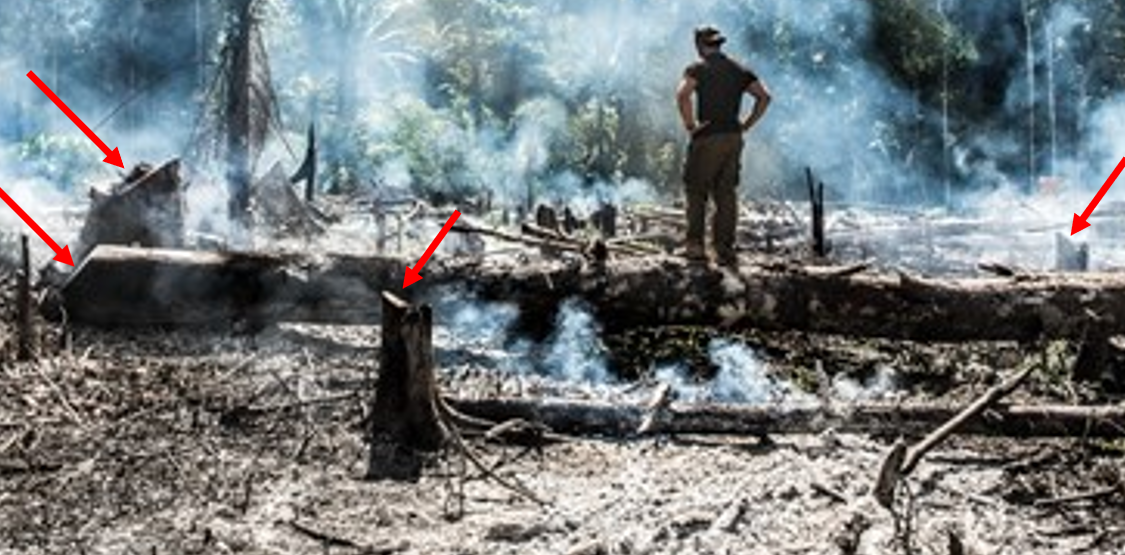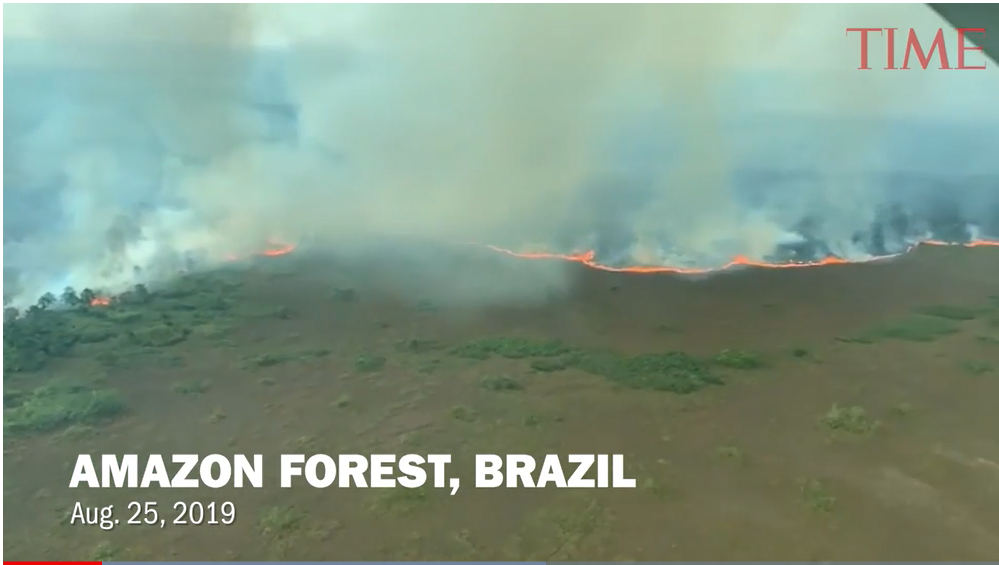Robert W. Endlich
” . . . the video short by TIME packs more falsehoods and deliberately misleading statements in such a short period of time, it seems to be establishing its own record of Fake News infamy.”
Maybe it was the tweet issued on 22 August 2019, two days prior to the G7 meeting in Biarritz France, by French President Emmanuel Macron, that focused the main-stream media on “fires in the Amazon.” Macron’s appeal to the G7 principals may have been made with good intentions, but it was soon discovered that the image allegedly of the burning Amazon rain forest was taken by the late photographer Loren McIntyre who passed away in 2003, which meant that the photo used by Macron was at least sixteen years old!
The UK Express wrote that the photo used by Macron might even have been from McIntyre’s reports from the Amazon for National Geographic Magazine in the 1970s and 1980s. After Macron’s very splashy tweet, it seems this entire story is laced with very fake news.
THERE IS LOTS MORE
NBC News’ Morning Briefing on 23 August speaks of possible “’game over’ for climate change fight,” but when I looked at the first photo, among the smoldering trees are prominent trunks cut by chain saws, evidence the trees were cut, left to dry, and set alight in the dry season by farmers—not virgin forests burning.


NBC Morning Briefing’s other image of a tired man walking from the flames was cleared farmland burning; there were no forest trees, only burning shrubs and dried ground “crop remains” in the image.

A Science Alert story “Amazon…Burning at a Record Rate” showed huge flames in trees, but the fine print showed the fire image was from five years ago, in 2014. Similarly, a CNN story has a headline blaring, “Fires are raging in the Amazon forest,” but just looking at the images shows flames burning dried vegetation in cleared farmland, not “Amazon forest.”

The Los Angeles Times “…Amazon rain forest is on fire,” story shows belching dark yellow and brown smoke, but the fire boundaries are squared off along a dirt road, showing that this is not Amazon rain forest, but cleared farmland torched off to burn the land for crop planting when the next rainy season returns.
The BBC’s Latin American edition pitched in: “Amazon fires: Record Number burning in Brazil rain forest – space agency.”
Whoops. Now (26 Sep 2019) there is a correction at the end:
“This article initially stated there was a record number of fires in Brazil this year. After more satellite data was made accessible, it has been updated to reflect the fact the fires are instead the worst since 2010.”
THE REAL CLIMATE STORY
There IS a climate backstory, but it’s not the story the climate alarmist writers and political leaders have bothered to tell. The Amazon where these fires are burning is part of the “tropical wet season-dry season” area of South America. Rather than being affected by the traveling storms typical of temperate regions of the world, these are the tropics, and the alternating “Wet Season-Dry Season” tropical pattern is dominant there. This two-season year is driven by the annual migration of the sun over the land and the enormous differences between Northern and Southern Hemisphere land areas. The vast oceans modulate this warming-cooling pattern, so the slow warming of the oceans controls the wet season-dry season progression.
What does this mean for those of us in temperate regions and those in the Amazon region? It’s almost everything pertaining to rainfall, crops, harvest, and the long Amazon dry season.
I write this in late September 2019, in the northern Hemisphere, when the seas have just reached their warmest temperatures of the year. Hurricane season. The East Coast states of the USA which have a mostly even distribution of rainfall by month, see a bump in late summer, as a result of the occasional hurricane landfalls this time of year. The Inter Tropical Convergence Zone, ITCZ, reaches its maximum pole ward extent around this time of year.
But in the Amazon, its dry season.
Many farmers in the Amazon use poor-man’s fertilizer to temporarily enrich the poor laterite soils of the tropics using slash-and-burn agriculture, a practice widespread in tropical latitudes.
Slash-and-burn works like this: farmers clear the land. Nowadays many use machines, bulldozers and tractors with chains instead of the axes and machetes of past practice. They let the fallen trees and shrubs dry out, then torch it during the dry season; this is what produces those huge pillars of smoke and the reductions to visibility in smoke at the surface and aloft. Fifty years ago, when I was flying missions in Southeast Asia, I likened it to flying in chocolate milk.
The ash is plowed under and crops are grown on the cleared land. After harvest, the “crop remains” dry out and they, too, are torched at the height of the next year’s dry season, and new ash helps the following crop.
After a couple of seasons, the soil becomes less fertile, the farmer moves on, cuts down another swath of forest, waits for the sun to dry out the biomass on this new farmland, and the next burning of the cut down trees occurs.
Sensors on NASA satellites, mainly the MODIS imager on NASA’s Aqua and Terra satellites observe this; the data are shared with partner organizations. In Brazil, it is the National Institute for Space Research, INPE.
So, we have a history of the amount of land cleared over the Amazon when viewed from above, and that history goes back to at least 1988. That history also includes the number of, location of, and area of the fires. The data are available. So, what does this history reveal? The data plainly show that the maximum area cleared occurred 1995-2005. And the maximum number of fires in the Amazon, January through August, occurred from 2002-07.
An excellent graphic from the New York Times compares the August average of fires 2011-2018 with the fires in 2019, and this clearly shows that compared with the recent average, the number of fires in 2019 was distinctly less than that 2011-2018 average.
TIME TOPS THE FAKE NEWS LIST
While there are clearly deceptive elements in the stories mentioned above by NBC, CNN, and the Los Angeles Times, the 26 August 2019 story by Zoe Sullivan and especially the video short by TIME packs more falsehoods and deliberately misleading statements in such a short period of time, it seems to be establishing its own record of Fake News infamy. Let me list a few:
Just 4 seconds in, the video says, “The Amazon rain forest has seen a record number of forest fires in 2019,” yet the data from INPE shows ten separate dry seasons since 2002 having distinctly more fires, with peaks in 2003-2007 and 2010.
From 0:09 to 0:17 the video, showing a flyover of fires, says, “Amazon Forest, Brazil 2019,” but the burning area clearly is NOT forest, but cleared, dry farmland.

At 0:35 the text of the video says, “The INPE said on Aug 20 that it has so far detected an 83% increase from the same time period in 2018,” perhaps true, but Ms. Sullivan is being deliberately deceptive because 2019’s fires are well under half the number counted in the peak year of 2005 and this year’s fire numbers are typical of the year to year variability seen in the entire record. It would be fair to call this “yellow journalism.”
At 0:45, the video says, “It’s the highest number of fires recorded since 2013, when record-keeping began.” What deliberate deception! Even data from the Los Angeles Times show that their number of forest fires from INPE starts in 2000 and was greater than 2019 in 2002-2007 and 2010, seven separate dry seasons with more fires than 2019.
Beginning at 0:51 and especially at 1:09 we see the politics of TIME emerge from the smoke of the video, it clearly is a hit piece on right of center President Jair Bolsonaro, who at that time is shown in a dark scene with text, “Less than a year into his tenure, the Amazon in Brazil has lost 1330 square miles of forest cover…” Truth is, this is tiny compared with the 10,722 square miles lost to deforestation in 2004, but 2004 this was when Workers Party President Lula was in power.
Dr Roy Spencer who frequently examines and posts on the MODIS satellite imagery and data commented, on the 2019 dry season burning, “This year is not exceptional in this regard, yet someone decided to make an issue of it this year. In fact, it looks like 2019 might be one of the lowest years for biomass burning. Deforestation there has gone down dramatically in the last 20 years.”
A fitting conclusion!
